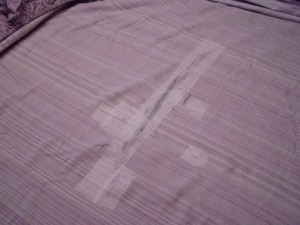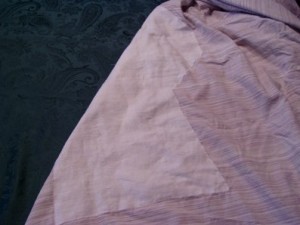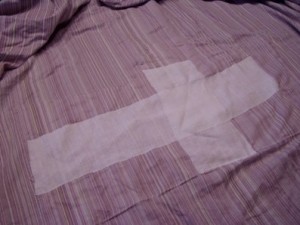 The sheets supposedly chosen as being the finest (whatever that means – ‘best quality? Most comfy? Hardest wearing? No clue) in the world are supposedly made by Thomas Lee. They are 500 threat count pima cotton. best sheets They cost $239 regular/ $179 on special. That’s one fitted, one flat, and two pillowcases.
The sheets supposedly chosen as being the finest (whatever that means – ‘best quality? Most comfy? Hardest wearing? No clue) in the world are supposedly made by Thomas Lee. They are 500 threat count pima cotton. best sheets They cost $239 regular/ $179 on special. That’s one fitted, one flat, and two pillowcases.
Now, it’s not that Aunt Toby and the DH are willing to sleep on burlap sacks. A good closely woven cotton (ok, perhaps with a bit of poly in it) sheet set is a joy to sleep on (especially after they are freshly put on the bed, after you’ve had a nice hot bath, and..oh, we won’t go there) and anything else can be frankly annoying. But one problem with sheet sets is this: The sheet where, ahem, the rubber meets the road, is the sheet that starts to wear out first. And unless your linen closet is stocked 100% with one single color (no prints, no weird stuff, no 1970s hippy dippy Indian prints in gold and burgundy) and it’s the same color, then if you wear out the bottom 25% of your bottom fitted sheet (I’m talking to you, Mr. “Won’t trim the toenails”), then you have a flat and two or more pillow cases that do not go with anything else.
Instant candidates for the rag bag or out into the garbage and off into the landfill far away. And usually that flat and the pillow cases are in just fine condition, thank you very much. So, pitching all of that, no matter how much you paid for the sheet set can be more than a bit of a waste.
Many of us who read Laura Ingalls Wilder’s “Little House” series may recall her description of making sheets: Because the looms for muslin did not make the fabric wide enough for sheets, the girls and women would have to take two lengths (long enough to tuck under the mattress at both ends) and oh-so-carefully seam them up the middle with teeny little stitches, in a flat way, to make two flat sheets (America had to go without fitted sheets until an African America inventor, Bertha Berman, was awarded the patent for the invention in October, 1959. Bertha Berman Patent).
The really good thing about linens, under the Laura Ingalls Wilder regime, is that as the middle of the sheet wore out (and the middle of the sheets always wore out first, especially if one sheet was perpetually used as the bottom sheet), the household sewer could take out the stitches, flip the two halves and resew up the outside edges now to the center seam and the center area which was now worn, would be on the outside. The sheet would wear evenly that way and by the time it was done for, it really was worn out and probably would be taken apart, sewn up into something like curtains or used for other things. Once America had two nice matching flat sheets, households could just rotate through the flats and wear them out evenly that way also.
But we, post-Bertha Berman, buy our sheets in sets, with only one fitted bottom sheet, which wears out and leaves us hanging out there with the extra flat sheet and the pillow cases. Cannon Mills, et al. should raise their glasses on a regular basis to Bertha Berman for insuring that they have a steady market in households that have to throw out the usable rest of sheet sets and buy entirely new sheet sets just because the fitted bottom sheet has worn.
And so, Aunt Toby and the DH have found themselves with a bottom flat queen sized sheet from a very nice set which frankly someone (cough) put his toe nails through … and which I am not willing to pitch. I realize there are people (I can hear the eyeballs rolling back into people’s heads right now), regular readers all, who are now saying to themselves, “Oh, no, now she’s going to tell us to repair the damn sheet.”
 Yep, that is exactly what Aunt Toby is going to show you how to do. This is frankly a patch job. I admit it, but it’s at the bottom 25% of the sheet; no one but the inhabitants of my bedroom will ever see it and all it will do is provide the DH and me with a certain feeling of Puritanial thriftiness that a) we could still keep using all of the sheet set and b) that we would not be putting more stuff into the landfill that truly does not belong there.
Yep, that is exactly what Aunt Toby is going to show you how to do. This is frankly a patch job. I admit it, but it’s at the bottom 25% of the sheet; no one but the inhabitants of my bedroom will ever see it and all it will do is provide the DH and me with a certain feeling of Puritanial thriftiness that a) we could still keep using all of the sheet set and b) that we would not be putting more stuff into the landfill that truly does not belong there.
Here’s what you do:
Using a lightweight iron-on fusible interfacing, pull the edges of the rip together and iron a piece over to hold everything in place. If there are other odd holes, patch with small pieces.
 Make two patches. The first one, for the underside of the sheet, should not only go over the ripped places, but over the entire worn area. If you are not sure how far that extends, hold the sheet up to the light – you’ll be able to more easily see through the worn area. Make the patch for the underside slightly larger than the worn area, pin on top and sew that on. Don’t bother with hemming the patch; use your zigzag stitch. I also go across a couple of times to hold everything in place. The second patch, for the top, should just go across the actual rip itself. Between these two patches, you will have a solid, well wearing area that should withstand even the thorniest toe nails.
Make two patches. The first one, for the underside of the sheet, should not only go over the ripped places, but over the entire worn area. If you are not sure how far that extends, hold the sheet up to the light – you’ll be able to more easily see through the worn area. Make the patch for the underside slightly larger than the worn area, pin on top and sew that on. Don’t bother with hemming the patch; use your zigzag stitch. I also go across a couple of times to hold everything in place. The second patch, for the top, should just go across the actual rip itself. Between these two patches, you will have a solid, well wearing area that should withstand even the thorniest toe nails.
Fabrics to use. On this sheet, I used a shirt weight linen – because I’ve got it from a project I did for the DH. Other fabrics you can use are muslin (regular or bleached, though bleached will not wear as well; bleaching will weaken the fibers). Just make sure the fabric has been washed in hot water, dried and ironed flat.
Happy sheets!

When my fitteds are over the hill, the flats get moved to the sewing room. I use the more worn ones for muslins, or part of quilt linings. The less used ones are often turned into summer wear for the Kid. She is at the age where she is very hard on summer clothes, and sheets make great outdoor playing clothes. You can wash them hard, bleach them, and hang ’em to dry with little wear and tear. For the inevitable knee grass stains, I use the washboard and bar soap with no problems at all…
I love the idea of repairing the fitted when possible though!